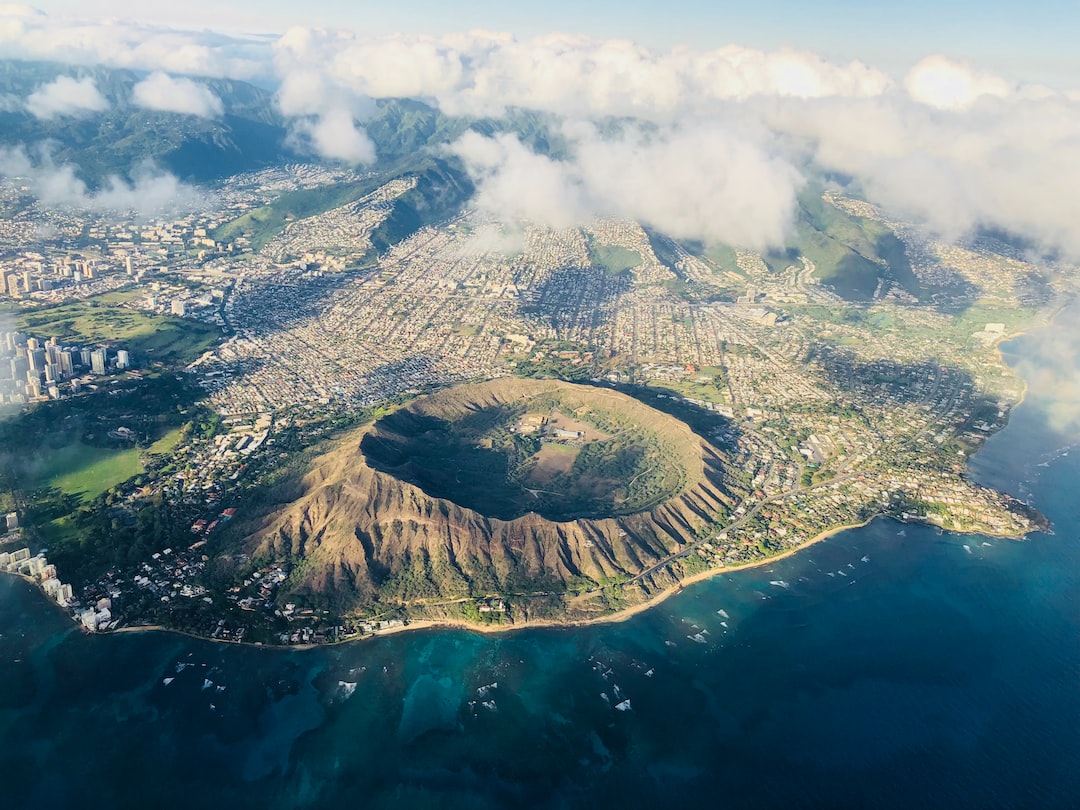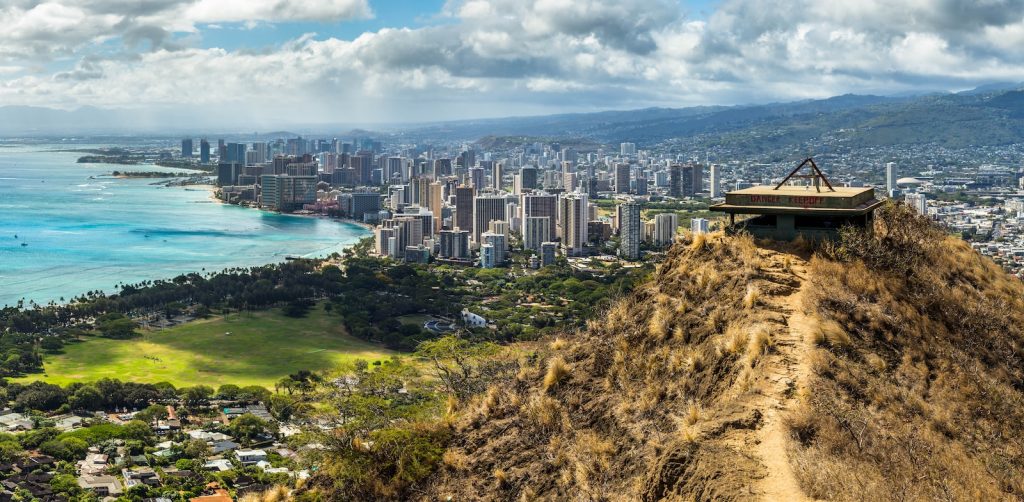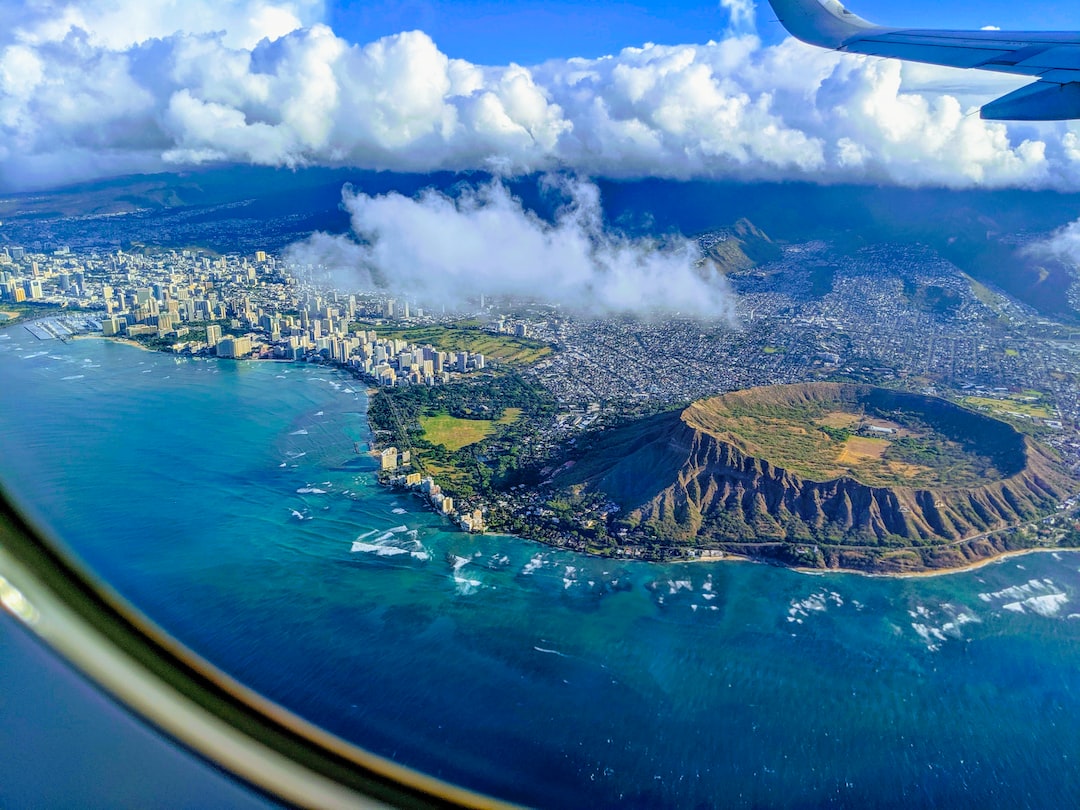Arguably one of the most iconic landmarks in Hawaii, Diamond Head is a must-visit site for any outdoor enthusiast looking to experience the breathtaking views the volcanic crater offers. The entire hiking experience is nothing short of remarkable, taking you through a unique trail with an invigorating ascent that can be cherished by both beginners and experienced hikers alike.
The Diamond Head Hike in Honolulu, Hawaii, takes around 1.5 to 2 hours to complete, covering a distance of 1.6 miles round trip. Ascending 560 feet, the moderately challenging trail offers stunning coastal and city views. The hike starts at the Diamond Head State Monument and features switchbacks, stairs, and a tunnel along the path.
What Should You Know Before Embarking on the Diamond Head Hike?
It’s essential to be well-prepared before you head out on your hiking adventure up Diamond Head. This means more than just having the right gear and supplies; it also involves understanding what to expect during the hike concerning the terrain, the best time to visit, and the hike’s actual duration.
Terrain and Trail Conditions
The 1.6-mile round-trip trail is a mix of uneven dirt paths, concrete walkways, steep stairs, and even a tunnel. While the beginning of the trail is relatively straightforward, consisting mostly of a paved surface and a tunnel, it quickly turns into an increasingly steeper ascent with rocky and uneven paths. As such, make sure to wear appropriate footwear with good grip and support.
During periods of heavy rainfall, the trail can get muddy, making it slippery and more challenging to navigate. In my experience, it’s best to avoid these conditions if you’re not an experienced hiker.
Best Time to Visit Diamond Head
Ideally, the best time to hike Diamond Head is between April and October when the weather is dryer with less chance of heavy rainfall. It’s recommended to begin your hike early in the morning, around 6:30 am, to avoid the midday heat and large crowds. Not only will this give you a more peaceful and enjoyable hiking experience, but it also allows you to watch the sunrise over the beautiful landscape.
How Long Does the Diamond Head Hike Take?
The duration of the hike will vary depending on your fitness level, pace, and whether you choose to stop and take in the sights along the trail. Generally, the hike will take anywhere from 1.5 to 2 hours for the entire round trip.
What Are Some Tips for Hiking Diamond Head?
Now that you’re familiar with the basics, it’s time to discuss some helpful tips to make your hiking experience at Diamond Head memorable and enjoyable. From safety precautions to sightseeing opportunities, these insights will ensure you have a fantastic time on the trail.
Safety Tips for Hiking Diamond Head
Since safety is always a top priority when embarking on any outdoor adventure, consider these essential safety tips when hiking Diamond Head:
1. Stay hydrated: Given the volcanic crater’s dry and often hot conditions, it’s crucial to bring enough water (at least one liter per person) to stay hydrated throughout the hike.
2. Use sunscreen: With limited shade along the trail, you’ll likely be exposed to direct sun for most of the hike. Applying sunscreen, wearing a hat, and using sunglasses will protect you from the sun’s harmful rays.
3. Know your limits: While the hike is beginner-friendly, it can be challenging for some, particularly during the steep ascent. Listen to your body and take rest breaks as needed.
4. Stick to the trail: Avoid venturing off the designated path to protect the fragile ecosystem and to prevent falling or getting lost.
What Points of Interest Can You Expect Along the Trail?
While the hike is an exhilarating adventure in its own right, it wouldn’t be complete without taking the time to absorb the stunning scenery it offers. Some points of interest you can expect to see:
1. The Kahala Lookout: This lookout, located halfway up the trail, offers extraordinary views of Oahu’s eastern coastline and the Kahala neighborhood.

2. WWII Bunker: Built in 1911 and serving as a part of Oahu’s coastal defense system, this bunker, located just below the summit, offers a glimpse into Hawaii’s military history.
3. Summit Views: Once you reach the summit, your efforts will be rewarded with 360-degree panoramic views, encompassing Waikiki, Oahu’s southern coastline, and the Pacific Ocean.
How Can You Make the Most of Your Diamond Head Hike Experience?
While you might be lured by the prospect of simply hiking Diamond Head, there are more opportunities to make the most of your time there. By extending your trip just a bit or exploring nearby attractions, your time at Diamond Head can turn into the experience of a lifetime.
Combine Your Diamond Head Hike with Nearby Attractions
Diamond Head is conveniently located close to several other notable attractions in Hawaii, allowing you to maximize your day out. Some must-visit sites include:
1. Kapiolani Park: Considered Hawaii’s oldest public park, Kapiolani Park’s 300 acres offer stunning gardens and recreational spaces, ideal for a post-hike picnic.
2. Waikiki Aquarium: A short drive from the trailhead, the Waikiki Aquarium showcases the colorful marine life of the Hawaiian Islands and the Pacific Ocean.
3. Honolulu Zoo: If you’re looking to explore the region’s diverse wildlife, head south of Kapiolani Park to Honolulu Zoo, where you’ll encounter animals from the Africa, Asia, and Pacific Islands.
4. Waikiki Beach: After completing your hike, visit the renowned Waikiki Beach to unwind, sunbathe, or even attend surfing lessons.
Guided Tours of Diamond Head
For those looking to immerse themselves in the history and ecosystem of Diamond Head, a guided tour can provide an enriching experience. Several reputable tour operators offer guided hikes with local experts who can share their knowledge and insights on everything from the volcanic crater’s formation to the flora and fauna inhabitants of the area.
In addition to valuable information, guided tours can also provide assistance with transportation and supply you with hiking gear, such as walking sticks, making your hike both comfortable and enlightening.
Preparing for Your Diamond Head Hike
To have a smooth and enjoyable hike up Diamond Head, proper preparation is key. Not only will it ensure your safety, but it will also enhance your overall experience. Here’s a checklist of items and preparations to consider before embarking on your hike:
1. Gear and Clothing: Wear comfortable and moisture-wicking clothing to help maintain a comfortable body temperature during your hike. A hat, sunglasses, and sunscreen are also essential to protect you from sun exposure. As for footwear, opt for a pair of hiking shoes or boots with good traction and ankle support, as the trail can be rocky and uneven in some sections.
2. Snacks: Bring along energy-boosting snacks like trail mix, granola bars, and fruit to keep yourself fueled during the hike. Be sure to carry them in a resealable bag or airtight container to prevent attracting insects or animals.
3. Backpack: Invest in a lightweight and comfortable backpack to carry all your essentials during the hike. It should also include a hydration system or compartments to store water bottles easily.
4. Camera or Smartphone: Don’t forget your camera or smartphone to capture the incredible views and memorable moments throughout the hike. Make sure to have your devices fully charged or carry extra batteries.

Other Activities at Diamond Head State Monument
Apart from the hike, Diamond Head State Monument offers more than just the main trail. Visitors can take part in several other engaging activities while visiting this Hawaiian gem. Some examples include:
1. Bird Watching: Diamond Head is home to numerous native and migratory bird species, making it an ideal spot for bird watching enthusiasts. Look out for species like the white-tailed tropicbird or the red-tailed tropicbird soaring near the crater rim.
2. Diamond Head Visitor Center: Before or after your hike, drop by the Diamond Head Visitor Center where you can learn more about the crater’s history, geology, and cultural significance. In addition, you can purchase souvenirs, maps, and snacks.
3. Cultural Events and Festivals: Occasionally, Diamond Head serves as a venue for local cultural events, concerts, and festivals. Keep an eye on the park’s events calendar to participate in such events during your visit.
4. Photography: Diamond Head crater, summit, and surrounding landscape offer fantastic opportunities for photography enthusiasts to capture stunning images. Experiment with various angles, perspective, and lighting conditions to create breath-taking photos.
Preserving the Diamond Head Environment
As a fragile ecosystem and an essential part of Hawaii’s history and culture, it’s crucial to preserve and protect Diamond Head for future generations to enjoy. When venturing on your hike, always practice the Leave No Trace Principles to minimize your impact on the environment. Some essential guidelines include:
1. Stay on designated trails and avoid trampling on vegetation or disturbing wildlife.
2. Carry out all trash, including food wrappers, tissues, and water bottles, to dispose of properly outside the park.
3. Do not collect or disturb any natural or cultural artifacts, such as rocks, plants, or historic structures.
4. Be respectful of other hikers by maintaining a reasonable noise level and yielding the trail when necessary.
By following these principles, you’re not only ensuring a memorable and enjoyable experience for yourself but also helping preserve the unique beauty and essence of Diamond Head for years to come. With adequate preparation, you’re now set to tackle the remarkable Diamond Head hike, make the most of your day, and create lasting memories in this iconic Hawaiian landscape. Happy trails!
Up Close with the Diamond Head Formation
An essential aspect of fully appreciating the Diamond Head hike lies in understanding the intricacies behind its unique geological formation. This volcanic tuff cone was formed some 300,000 years ago during a single, powerful volcanic eruption that spewed ash and debris into the air. Over time, the elements solidified into the tuff, leading to the creation of the crater walls and the uneven, rugged terrain that defines the hiking experience.

During the hike, you’ll have the opportunity to observe the various layers of tuff and rock formations, which serve as testament to the power of Hawaii’s volcanic activity. In addition, by learning about Diamond Head’s geological history, you can better appreciate the views it has to offer as well as the effort, patience, and resilience of nature in creating such fascinating landscapes over time.
Venturing Beyond the Main Diamond Head Hiking Trail
While the primary hiking trail attracts the majority of visitors, Diamond Head State Monument also boasts several lesser-known, off-the-beaten-path trails that you can explore if you’re seeking a more challenging and secluded experience. Some of these additional trails include:
1. Diamond Head Interior Crater: This 3.2-mile loop trail begins at the summit and winds around the crater’s interior, offering an intimate perspective of the crater floor and its lava formations.
2. Diamond Head Cliffs Trail: This 3-mile out-and-back trail features a more challenging rocky ascent, taking you along the volcanic cliffs that form the crater rim. The trail offers stunning ocean views and an opportunity to visit an old seaside gun emplacement, known as Battery Harlow.
Before venturing onto these alternative routes, it’s crucial to familiarize yourself with the trail conditions, difficulty levels, and park regulations. Some trails may require more advanced hiking skills and preparations, ensuring a safe and enjoyable experience.
Optimizing Your Physical Preparedness for the Diamond Head Hike
While the Diamond Head hike is generally beginner-friendly, it can be challenging, primarily during steep ascents and in hot conditions. To ensure you have an enjoyable and stress-free hiking experience, it’s essential to optimize your physical preparedness before embarking on the trail.
To accomplish this, consider incorporating regular cardiovascular exercises such as running or swimming into your routine, focusing on building your stamina and endurance. Additionally, workouts targeting your leg muscles, such as lunges, squats, and step-ups, can improve your strength and ability to tackle the steep inclines along the trail.
For inexperienced hikers or those unsure of their physical capabilities, a gradual introduction to hiking can be advantageous. Start with shorter, less challenging hikes in your local area and gradually build up to more strenuous trails, ultimately preparing you for the Diamond Head adventure.
Insights on Diamond Head Flora and Fauna
Amidst the vast volcanic landscape of Diamond Head lies a thriving ecosystem, inhabited by a variety of unique flora and fauna that contribute to Hawaii’s rich biodiversity. While the harsh, dry conditions might lead some to believe that vegetation and wildlife would struggle to thrive within the crater, numerous resilient species have adapted to the environment.
Some intriguing inhabitants that you may encounter during your hike include:
1. Native plants: Species such as ‘a’ali’i, koa, and ilima are found in the area, displaying adaptations like small leaves and deep roots that allow them to survive in the arid conditions.
2. Invasive plants: Some invasive species like kiawe and fountain grass have established themselves within the crater, competing with native plants for resources.
3. Seabirds: Diamond Head’s rocky cliffs serve as nesting sites for seabirds like the red-footed booby, white-tailed tropicbird, and red-tailed tropicbird. Keep an eye out for these birds soaring above the crater rim.
4. Insects: Endemic insects, such as the Kamehameha butterfly and the Hawaiian yellow-faced bee, are essential pollinators for native plants, allowing the ecosystem to flourish despite the harsh conditions.
By paying close attention to your surroundings, you’ll come to appreciate the delicate balance of life within Diamond Head and the wondrous, ever-adapting world of nature. With this newfound knowledge and appreciation for Diamond Head’s geological, historical, and environmental significance, you’re ready to conquer the trail with confidence and enthusiasm. Remember to stay safe, respect the environment, and cherish every moment of the captivating Diamond Head hiking experience.





